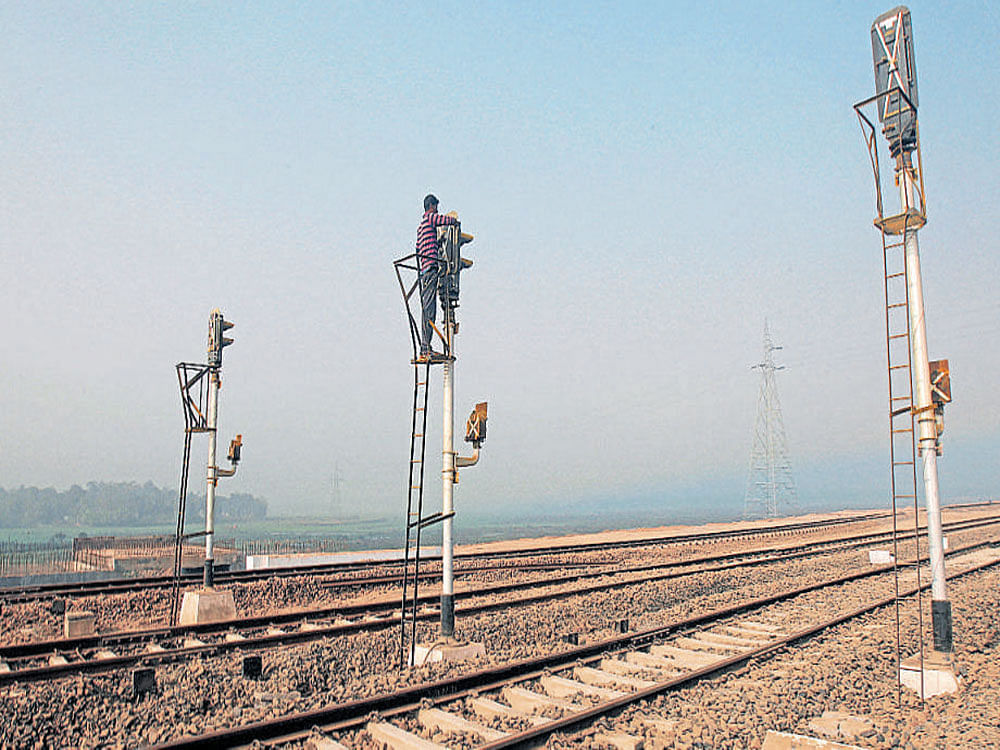You may be thinking that the ‘gau rakshak’ gangs attacking cattle-transporting vehicles and publicly lynching Muslims and Dalits and the crackdown by governments on slaughterhouses have saved millions of cows.
The truth is, more and more old cattle, after being abandoned, are now coming under the wheels of Indian Railways trains.
In other words, rail tracks have become the new slaughterhouse. Some 80 cows are being killed this way each day, and Railways is helpless in preventing the gruesome deaths on the track.
According to Railways data, about 2,500 heads of cattle are coming under speeding trains each month across the country. The maximum cases are being reported from the Hindi heartland.
The number of heads of cattle coming under moving trains has gone up from about 3,000 in 2014-15 to over 14,850 in 2017-18 and nearly 32,000 in 2018-19, a ghastly record jump, causing deep concern for railway authorities.
While about 18,900 trains were affected in 2017-18, nearly 43,000 trains were cattle-hit in 2018-19, according to Railways’ internal data.
In the current fiscal, about 5,500 ‘cattle run over’ (CRO) cases have been recorded, affecting over 7,000 trains, during just the April-May period.
More and more cows are dying on the tracks each day across the country but especially in North India, a senior Railway ministry official responsible for ensuring safety in train operation, said.
The official said the CRO problem has grown since the emergence of cow vigilante groups in the Hindi heartland. Thus, the Railways has a strange problem on hand.
Due to various measures, particularly the elimination of unmanned level crossings, consequential train accidents have decreased from 135 in 2014-15 to 59 in 2018-19.
In 2017-18, there were 73 train accidents. But while the number of general train accidents has been declining, the significant jump in CRO cases has become a cause of serious concern for safe train operations.
Quite clearly, the increase in cow deaths on the tracks is due to two major reasons: Firstly, especially in North India, there are an inadequate number of cattle shelters or ‘gaushalas’ for old or abandoned cows.
Secondly, because of stricter cattle trading and slaughter laws, there are more old cows roaming around than ever before. With the crackdown on slaughterhouses, most cattle owners end up simply abandoning cattle that are old and have stopped producing milk. These cows are roaming in the open because there is no buyer for them and the promised ‘gaushalas’ are nowhere to be seen.
The cows are also destroying crops, forcing farmers to chase them out of their fields. Railway lines are near fields, and the cattle go to open areas near the railway lines to graze.
According to sources, Indian Railways security personnel and station staff try to sensitise villagers about the danger of CRO cases, but this does not seem to have helped.
Operations affected
While not every CRO case results in derailment, some do affect train operations for a few hours as the track needs to be cleared of the cattle carcass before allowing further movement. This not only hampers punctuality, it affects the speed of trains, too. Currently, the punctuality rate of trains is hovering around 71%.
Earlier this year, the newly-launched Vande Bharat Express, also known as Train 18, hit stray cattle and was damaged. The train’s aerodynamic nose, which is made of steel with a fibre cover on it, had to be replaced.
The stray cow menace can be tackled by wire-fencing or construction of walls along the tracks to prevent cattle from coming under trains. Indeed, there is a plan to fence off the main trunk routes between Delhi and Mumbai and the Delhi-Kolkata corridor to make train journey hassle-free and faster.
But it is just not possible to fence off the entire length of tracks nor guard the thousands of kilometres of rail lines round the clock. Though there is a greater need today of setting up more cow shelters across the country, there are also cases of cows dying in ‘gaushalas’ in large numbers due to the lack of fodder and care.
There are cases of cows thus dying at Prayagraj (Allahabad), Ayodhya, Mirzapur, Chandauli, Kannauj, Banda, Mahoba and Balrampur. In the Northeast, too, reports have emerged of cow deaths at ‘gaushalas’ due to lack of proper infrastructure and shortage of fodder.
It goes without saying that cows need to be prevented from going under the wheels of trains. Perhaps ‘gau rakshaks’ should stop lynching people in the name of the cow and head to the railway tracks, instead, to keep vigil, prevent cows from dying under trains and to take them to cow shelters.
And governments swearing by the cow should ensure that they set up enough such shelters and ensure that old cows have a good time there, with enough fodder and space to roam about.
(The writer is a senior Delhi-based journalist)
